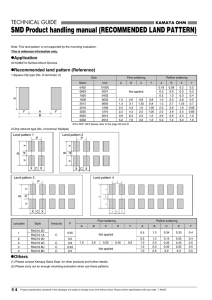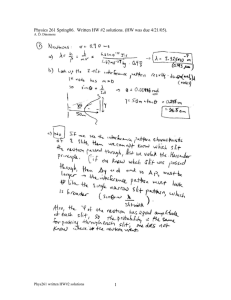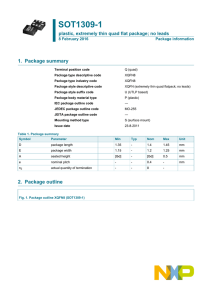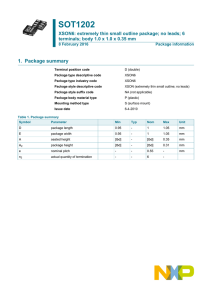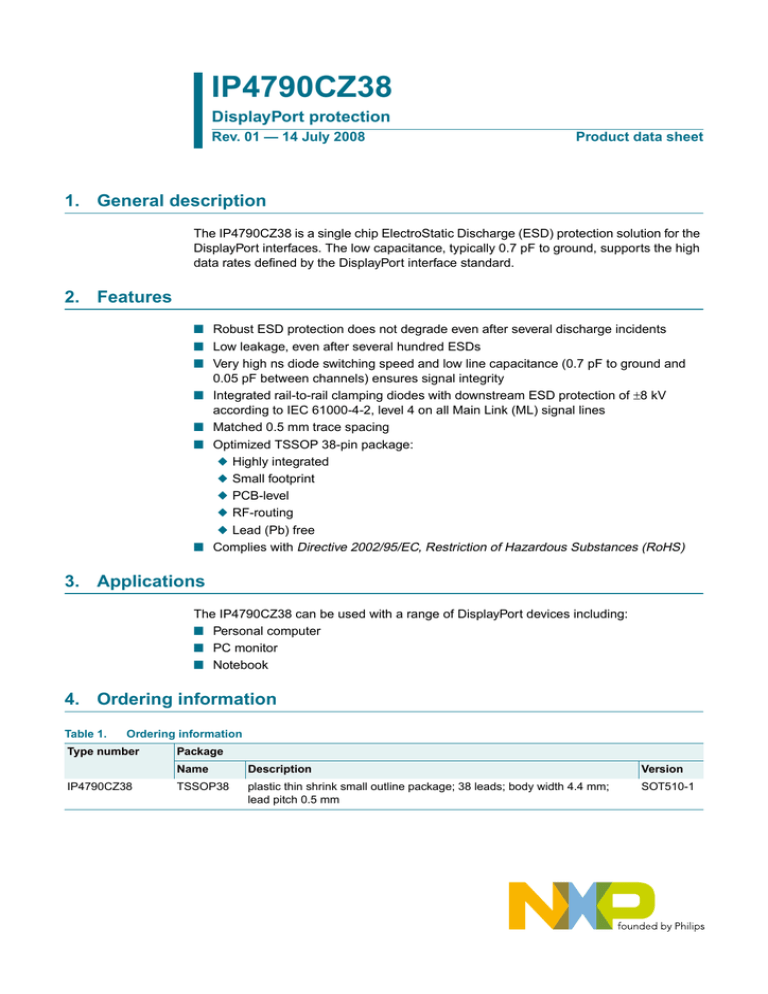
IP4790CZ38
DisplayPort protection
Rev. 01 — 14 July 2008
Product data sheet
1. General description
The IP4790CZ38 is a single chip ElectroStatic Discharge (ESD) protection solution for the
DisplayPort interfaces. The low capacitance, typically 0.7 pF to ground, supports the high
data rates defined by the DisplayPort interface standard.
2. Features
n Robust ESD protection does not degrade even after several discharge incidents
n Low leakage, even after several hundred ESDs
n Very high ns diode switching speed and low line capacitance (0.7 pF to ground and
0.05 pF between channels) ensures signal integrity
n Integrated rail-to-rail clamping diodes with downstream ESD protection of ±8 kV
according to IEC 61000-4-2, level 4 on all Main Link (ML) signal lines
n Matched 0.5 mm trace spacing
n Optimized TSSOP 38-pin package:
u Highly integrated
u Small footprint
u PCB-level
u RF-routing
u Lead (Pb) free
n Complies with Directive 2002/95/EC, Restriction of Hazardous Substances (RoHS)
3. Applications
The IP4790CZ38 can be used with a range of DisplayPort devices including:
n Personal computer
n PC monitor
n Notebook
4. Ordering information
Table 1.
Ordering information
Type number
IP4790CZ38
Package
Name
Description
Version
TSSOP38
plastic thin shrink small outline package; 38 leads; body width 4.4 mm;
lead pitch 0.5 mm
SOT510-1
IP4790CZ38
NXP Semiconductors
DisplayPort protection
5. Functional diagram
ML_0A
ML_1A
BIAS_CAP
ML_2A
ML_3A
VBIAS
ML_0B
BIAS_CAP
HOT_PLUG
ML_2B
BIAS_CAP
AUX_A
GND
Fig 1.
GND
ML_1B
ML_3B
BIAS_CAP
AUX_B
GND
GND
001aai165
Functional diagram
6. Pinning information
6.1 Pinning
VBIAS
1
38 BIAS_CAP
GND
2
37 GND
ML_0A
3
36 n.c.
n.c.
4
35 ML_0B
GND
5
34 GND
ML_1A
6
33 n.c.
n.c.
7
32 ML_1B
GND
8
31 GND
ML_2A
9
n.c. 10
30 n.c.
IP4790CZ38
29 ML_2B
GND 11
28 GND
ML_3A 12
27 n.c.
n.c. 13
26 ML_3B
GND 14
25 GND
n.c. 15
24 n.c.
n.c. 16
23 n.c.
n.c. 17
22 AUX_A
n.c. 18
21 AUX_B
n.c. 19
20 HOT_PLUG
001aai164
Fig 2.
Pin configuration SOT510-1 (TSSOP38)
IP4790CZ38_1
Product data sheet
© NXP B.V. 2008. All rights reserved.
Rev. 01 — 14 July 2008
2 of 11
IP4790CZ38
NXP Semiconductors
DisplayPort protection
6.2 Pin description
Table 2.
Pin description
Symbol
Pin
Description
VBIAS
1
bias voltage
GND
2
ground
ML_0A
3
main link 0A lane protection
n.c.
4
not connected
GND
5
ground
ML_1A
6
main link 1A lane protection
n.c.
7
not connected
GND
8
ground
ML_2A
9
main link 2A lane protection
n.c.
10
not connected
GND
11
ground
ML_3A
12
main link 3A lane protection
n.c.
13
not connected
GND
14
ground
n.c.
15, 16, 17, not connected
18, 19
HOT_PLUG
20
Hot Plug signal protection
AUX_B
21
auxiliary channel B protection
AUX_A
22
auxiliary channel A protection
n.c.
23, 24
not connected
GND
25
ground
ML_3B
26
main link 3B lane protection
n.c.
27
not connected
GND
28
ground
ML_2B
29
main link 2B lane protection
n.c.
30
not connected
GND
31
ground
ML_1B
32
main link 1B lane protection
n.c.
33
not connected
GND
34
ground
ML_0B
35
main link 0B lane protection
n.c.
36
not connected
GND
37
ground
BIAS_CAP
38
capacitor bias (optional)
IP4790CZ38_1
Product data sheet
© NXP B.V. 2008. All rights reserved.
Rev. 01 — 14 July 2008
3 of 11
IP4790CZ38
NXP Semiconductors
DisplayPort protection
7. Limiting values
Table 3.
Limiting values
In accordance with the Absolute Maximum Rating System (IEC 60134).
Symbol Parameter
Conditions
signal pins to ground: ML_xA, ML_xB,
AUX_A, AUX_B and HOT_PLUG
[1][2]
Min
Max
Unit
-
±8
kV
VESD
electrostatic discharge voltage
VVBIAS
voltage on pin VBIAS
GND − 0.5
5.5
V
Tstg
storage temperature
−55
+125
°C
Ptot
total power dissipation
-
0
mW
[1]
Human Body Model (HBM) according IEC 61000-4-2, level 4.
[2]
Where x = 0, 1, 2 and 3.
8. Characteristics
Table 4.
Characteristics
Tamb = 25 °C; unless otherwise indicated.
Symbol
Parameter
Conditions
Min
Typ
Max
Unit
VBRzd
Zener diode breakdown voltage
measured with I = 1 mA
6
-
9
V
VFd
diode forward voltage
-
0.7
-
V
[1]
-
0.1
5
µA
Pins ML_xA, ML_xB[1]
Ibck
back current
IRM
reverse leakage current
per ML channel; measured with V = 3.0 V
-
-
1
µA
Cch
channel capacitance
VVBIAS = 5 V; f = 1 MHz; Vch(ML) = 2.5 V
[2]
-
0.7
-
pF
VVBIAS = 5 V; f = 1 MHz; Vch(ML) = 2.5 V
[2]
-
0.05
-
pF
-
0.07
-
pF
∆Cch
channel capacitance difference
from pins ML_xA and ML_xB to bias; at
power-down; VVBIAS < Vch(ML)
Cch(mutual)
mutual channel capacitance
between signal pin and n.c. pin;
VVBIAS = 0 V; f = 1 MHz; Vch(ML) = 2.5 V
[2]
Rdyn
dynamic resistance
positive transient; measured with I = 1 A
[3]
-
2.4
-
Ω
negative transient; measured with I = 1 A
[3]
-
1.3
-
Ω
VESD = ±8 kV
[4]
-
8
-
V
VCL(ch)trt(pos) positive transient channel
clamping voltage
[1]
Where x = 0, 1, 2 and 3.
[2]
This parameter is guaranteed by design and verified by device characterization.
[3]
According to IEC 61000-4-5/9.
[4]
Human Body Model (HBM) according IEC 61000-4-2, level 4.
IP4790CZ38_1
Product data sheet
© NXP B.V. 2008. All rights reserved.
Rev. 01 — 14 July 2008
4 of 11
IP4790CZ38
NXP Semiconductors
DisplayPort protection
9. Application information
The IP4790CZ38 simplifies the protection of an DisplayPort interface.
IP4790CZ38
VBIAS
1
2
3
4
5
6
7
8
9
10
11
12
13
14
15
16
17
18
19
38
37
36
35
34
33
32
31
30
29
28
27
26
25
24
23
22
21
20
DisplayPort
1
ML_Lane 0(p)/3(n)
GND
ML_Lane 0(n)/3(p)
ML_Lane 1(p)/2(n)
GND
ML_Lane 1(n)/2(p)
ML_Lane 2(p)/1(n)
GND
ML_Lane 2(n)/1(p)
ML_Lane 3(p)/0(n)
GND
ML_Lane 3(n)/0(p)
GND
GND
AUX_CH(p)
GND
AUX_CH(n)
Hot Plug Detect
Return DP_PWR
DP_PWR
001aai175
Fig 3.
Typical application
Connecting an optional 100 nF capacitor to the BIAS_CAP pin (lead 38) enhances the
ESD protection clamping performance. The VBIAS pin reduces the capacitive load of the
ESD protection and VVBIAS can be in the range 2.5 V to 5.5 V.
IP4790CZ38_1
Product data sheet
© NXP B.V. 2008. All rights reserved.
Rev. 01 — 14 July 2008
5 of 11
IP4790CZ38
NXP Semiconductors
DisplayPort protection
10. Package outline
TSSOP38: plastic thin shrink small outline package; 38 leads; body width 4.4 mm;
lead pitch 0.5 mm
SOT510-1
E
D
A
X
c
HE
y
v M A
Z
20
38
A2
(A 3)
A
A1
pin 1 index
θ
Lp
L
1
19
bp
e
detail X
w M
2.5
0
5 mm
scale
DIMENSIONS (mm are the original dimensions).
UNIT
A
max.
A1
A2
A3
bp
c
D (1)
E (2)
e
HE
L
Lp
v
w
y
Z (1)
θ
mm
1.1
0.15
0.05
0.95
0.85
0.25
0.27
0.17
0.20
0.09
9.8
9.6
4.5
4.3
0.5
6.4
1
0.7
0.5
0.2
0.08
0.08
0.49
0.21
8
o
0
o
Notes
1. Plastic or metal protrusions of 0.15 mm maximum per side are not included.
2. Plastic interlead protrusions of 0.25 mm maximum per side are not included.
OUTLINE
VERSION
SOT510-1
Fig 4.
REFERENCES
IEC
JEDEC
JEITA
EUROPEAN
PROJECTION
ISSUE DATE
03-02-18
05-11-02
MO-153
Package outline SOT510-1 (TSSOP38)
IP4790CZ38_1
Product data sheet
© NXP B.V. 2008. All rights reserved.
Rev. 01 — 14 July 2008
6 of 11
IP4790CZ38
NXP Semiconductors
DisplayPort protection
11. Soldering of SMD packages
This text provides a very brief insight into a complex technology. A more in-depth account
of soldering ICs can be found in Application Note AN10365 “Surface mount reflow
soldering description”.
11.1 Introduction to soldering
Soldering is one of the most common methods through which packages are attached to
Printed Circuit Boards (PCBs), to form electrical circuits. The soldered joint provides both
the mechanical and the electrical connection. There is no single soldering method that is
ideal for all IC packages. Wave soldering is often preferred when through-hole and
Surface Mount Devices (SMDs) are mixed on one printed wiring board; however, it is not
suitable for fine pitch SMDs. Reflow soldering is ideal for the small pitches and high
densities that come with increased miniaturization.
11.2 Wave and reflow soldering
Wave soldering is a joining technology in which the joints are made by solder coming from
a standing wave of liquid solder. The wave soldering process is suitable for the following:
• Through-hole components
• Leaded or leadless SMDs, which are glued to the surface of the printed circuit board
Not all SMDs can be wave soldered. Packages with solder balls, and some leadless
packages which have solder lands underneath the body, cannot be wave soldered. Also,
leaded SMDs with leads having a pitch smaller than ~0.6 mm cannot be wave soldered,
due to an increased probability of bridging.
The reflow soldering process involves applying solder paste to a board, followed by
component placement and exposure to a temperature profile. Leaded packages,
packages with solder balls, and leadless packages are all reflow solderable.
Key characteristics in both wave and reflow soldering are:
•
•
•
•
•
•
Board specifications, including the board finish, solder masks and vias
Package footprints, including solder thieves and orientation
The moisture sensitivity level of the packages
Package placement
Inspection and repair
Lead-free soldering versus SnPb soldering
11.3 Wave soldering
Key characteristics in wave soldering are:
• Process issues, such as application of adhesive and flux, clinching of leads, board
transport, the solder wave parameters, and the time during which components are
exposed to the wave
• Solder bath specifications, including temperature and impurities
IP4790CZ38_1
Product data sheet
© NXP B.V. 2008. All rights reserved.
Rev. 01 — 14 July 2008
7 of 11
IP4790CZ38
NXP Semiconductors
DisplayPort protection
11.4 Reflow soldering
Key characteristics in reflow soldering are:
• Lead-free versus SnPb soldering; note that a lead-free reflow process usually leads to
higher minimum peak temperatures (see Figure 5) than a SnPb process, thus
reducing the process window
• Solder paste printing issues including smearing, release, and adjusting the process
window for a mix of large and small components on one board
• Reflow temperature profile; this profile includes preheat, reflow (in which the board is
heated to the peak temperature) and cooling down. It is imperative that the peak
temperature is high enough for the solder to make reliable solder joints (a solder paste
characteristic). In addition, the peak temperature must be low enough that the
packages and/or boards are not damaged. The peak temperature of the package
depends on package thickness and volume and is classified in accordance with
Table 5 and 6
Table 5.
SnPb eutectic process (from J-STD-020C)
Package thickness (mm)
Package reflow temperature (°C)
Volume (mm3)
< 350
≥ 350
< 2.5
235
220
≥ 2.5
220
220
Table 6.
Lead-free process (from J-STD-020C)
Package thickness (mm)
Package reflow temperature (°C)
Volume (mm3)
< 350
350 to 2000
> 2000
< 1.6
260
260
260
1.6 to 2.5
260
250
245
> 2.5
250
245
245
Moisture sensitivity precautions, as indicated on the packing, must be respected at all
times.
Studies have shown that small packages reach higher temperatures during reflow
soldering, see Figure 5.
IP4790CZ38_1
Product data sheet
© NXP B.V. 2008. All rights reserved.
Rev. 01 — 14 July 2008
8 of 11
IP4790CZ38
NXP Semiconductors
DisplayPort protection
temperature
maximum peak temperature
= MSL limit, damage level
minimum peak temperature
= minimum soldering temperature
peak
temperature
time
001aac844
MSL: Moisture Sensitivity Level
Fig 5.
Temperature profiles for large and small components
For further information on temperature profiles, refer to Application Note AN10365
“Surface mount reflow soldering description”.
12. Revision history
Table 7.
Revision history
Document ID
Release date
Data sheet status
Change notice
Supersedes
IP4790CZ38_1
20080714
Product data sheet
-
-
IP4790CZ38_1
Product data sheet
© NXP B.V. 2008. All rights reserved.
Rev. 01 — 14 July 2008
9 of 11
IP4790CZ38
NXP Semiconductors
DisplayPort protection
13. Legal information
13.1 Data sheet status
Document status[1][2]
Product status[3]
Definition
Objective [short] data sheet
Development
This document contains data from the objective specification for product development.
Preliminary [short] data sheet
Qualification
This document contains data from the preliminary specification.
Product [short] data sheet
Production
This document contains the product specification.
[1]
Please consult the most recently issued document before initiating or completing a design.
[2]
The term ‘short data sheet’ is explained in section “Definitions”.
[3]
The product status of device(s) described in this document may have changed since this document was published and may differ in case of multiple devices. The latest product status
information is available on the Internet at URL http://www.nxp.com.
13.2 Definitions
Draft — The document is a draft version only. The content is still under
internal review and subject to formal approval, which may result in
modifications or additions. NXP Semiconductors does not give any
representations or warranties as to the accuracy or completeness of
information included herein and shall have no liability for the consequences of
use of such information.
Short data sheet — A short data sheet is an extract from a full data sheet
with the same product type number(s) and title. A short data sheet is intended
for quick reference only and should not be relied upon to contain detailed and
full information. For detailed and full information see the relevant full data
sheet, which is available on request via the local NXP Semiconductors sales
office. In case of any inconsistency or conflict with the short data sheet, the
full data sheet shall prevail.
13.3 Disclaimers
General — Information in this document is believed to be accurate and
reliable. However, NXP Semiconductors does not give any representations or
warranties, expressed or implied, as to the accuracy or completeness of such
information and shall have no liability for the consequences of use of such
information.
Right to make changes — NXP Semiconductors reserves the right to make
changes to information published in this document, including without
limitation specifications and product descriptions, at any time and without
notice. This document supersedes and replaces all information supplied prior
to the publication hereof.
Suitability for use — NXP Semiconductors products are not designed,
authorized or warranted to be suitable for use in medical, military, aircraft,
space or life support equipment, nor in applications where failure or
malfunction of an NXP Semiconductors product can reasonably be expected
to result in personal injury, death or severe property or environmental
damage. NXP Semiconductors accepts no liability for inclusion and/or use of
NXP Semiconductors products in such equipment or applications and
therefore such inclusion and/or use is at the customer’s own risk.
Applications — Applications that are described herein for any of these
products are for illustrative purposes only. NXP Semiconductors makes no
representation or warranty that such applications will be suitable for the
specified use without further testing or modification.
Limiting values — Stress above one or more limiting values (as defined in
the Absolute Maximum Ratings System of IEC 60134) may cause permanent
damage to the device. Limiting values are stress ratings only and operation of
the device at these or any other conditions above those given in the
Characteristics sections of this document is not implied. Exposure to limiting
values for extended periods may affect device reliability.
Terms and conditions of sale — NXP Semiconductors products are sold
subject to the general terms and conditions of commercial sale, as published
at http://www.nxp.com/profile/terms, including those pertaining to warranty,
intellectual property rights infringement and limitation of liability, unless
explicitly otherwise agreed to in writing by NXP Semiconductors. In case of
any inconsistency or conflict between information in this document and such
terms and conditions, the latter will prevail.
No offer to sell or license — Nothing in this document may be interpreted
or construed as an offer to sell products that is open for acceptance or the
grant, conveyance or implication of any license under any copyrights, patents
or other industrial or intellectual property rights.
13.4 Trademarks
Notice: All referenced brands, product names, service names and trademarks
are the property of their respective owners.
14. Contact information
For more information, please visit: http://www.nxp.com
For sales office addresses, please send an email to: salesaddresses@nxp.com
IP4790CZ38_1
Product data sheet
© NXP B.V. 2008. All rights reserved.
Rev. 01 — 14 July 2008
10 of 11
IP4790CZ38
NXP Semiconductors
DisplayPort protection
15. Contents
1
2
3
4
5
6
6.1
6.2
7
8
9
10
11
11.1
11.2
11.3
11.4
12
13
13.1
13.2
13.3
13.4
14
15
General description . . . . . . . . . . . . . . . . . . . . . . 1
Features . . . . . . . . . . . . . . . . . . . . . . . . . . . . . . . 1
Applications . . . . . . . . . . . . . . . . . . . . . . . . . . . . 1
Ordering information . . . . . . . . . . . . . . . . . . . . . 1
Functional diagram . . . . . . . . . . . . . . . . . . . . . . 2
Pinning information . . . . . . . . . . . . . . . . . . . . . . 2
Pinning . . . . . . . . . . . . . . . . . . . . . . . . . . . . . . . 2
Pin description . . . . . . . . . . . . . . . . . . . . . . . . . 3
Limiting values. . . . . . . . . . . . . . . . . . . . . . . . . . 4
Characteristics . . . . . . . . . . . . . . . . . . . . . . . . . . 4
Application information. . . . . . . . . . . . . . . . . . . 5
Package outline . . . . . . . . . . . . . . . . . . . . . . . . . 6
Soldering of SMD packages . . . . . . . . . . . . . . . 7
Introduction to soldering . . . . . . . . . . . . . . . . . . 7
Wave and reflow soldering . . . . . . . . . . . . . . . . 7
Wave soldering . . . . . . . . . . . . . . . . . . . . . . . . . 7
Reflow soldering . . . . . . . . . . . . . . . . . . . . . . . . 8
Revision history . . . . . . . . . . . . . . . . . . . . . . . . . 9
Legal information. . . . . . . . . . . . . . . . . . . . . . . 10
Data sheet status . . . . . . . . . . . . . . . . . . . . . . 10
Definitions . . . . . . . . . . . . . . . . . . . . . . . . . . . . 10
Disclaimers . . . . . . . . . . . . . . . . . . . . . . . . . . . 10
Trademarks . . . . . . . . . . . . . . . . . . . . . . . . . . . 10
Contact information. . . . . . . . . . . . . . . . . . . . . 10
Contents . . . . . . . . . . . . . . . . . . . . . . . . . . . . . . 11
Please be aware that important notices concerning this document and the product(s)
described herein, have been included in section ‘Legal information’.
© NXP B.V. 2008.
All rights reserved.
For more information, please visit: http://www.nxp.com
For sales office addresses, please send an email to: salesaddresses@nxp.com
Date of release: 14 July 2008
Document identifier: IP4790CZ38_1


